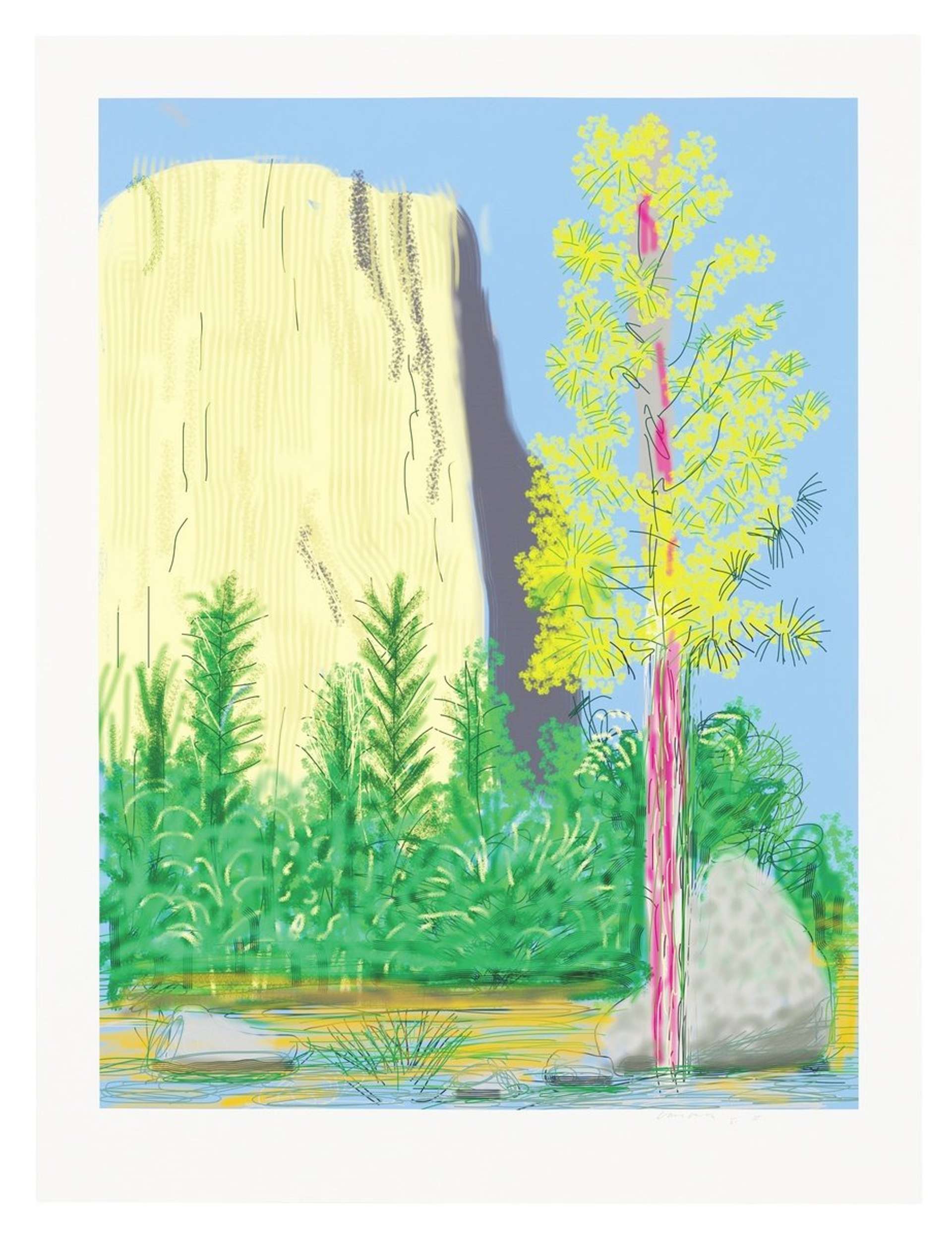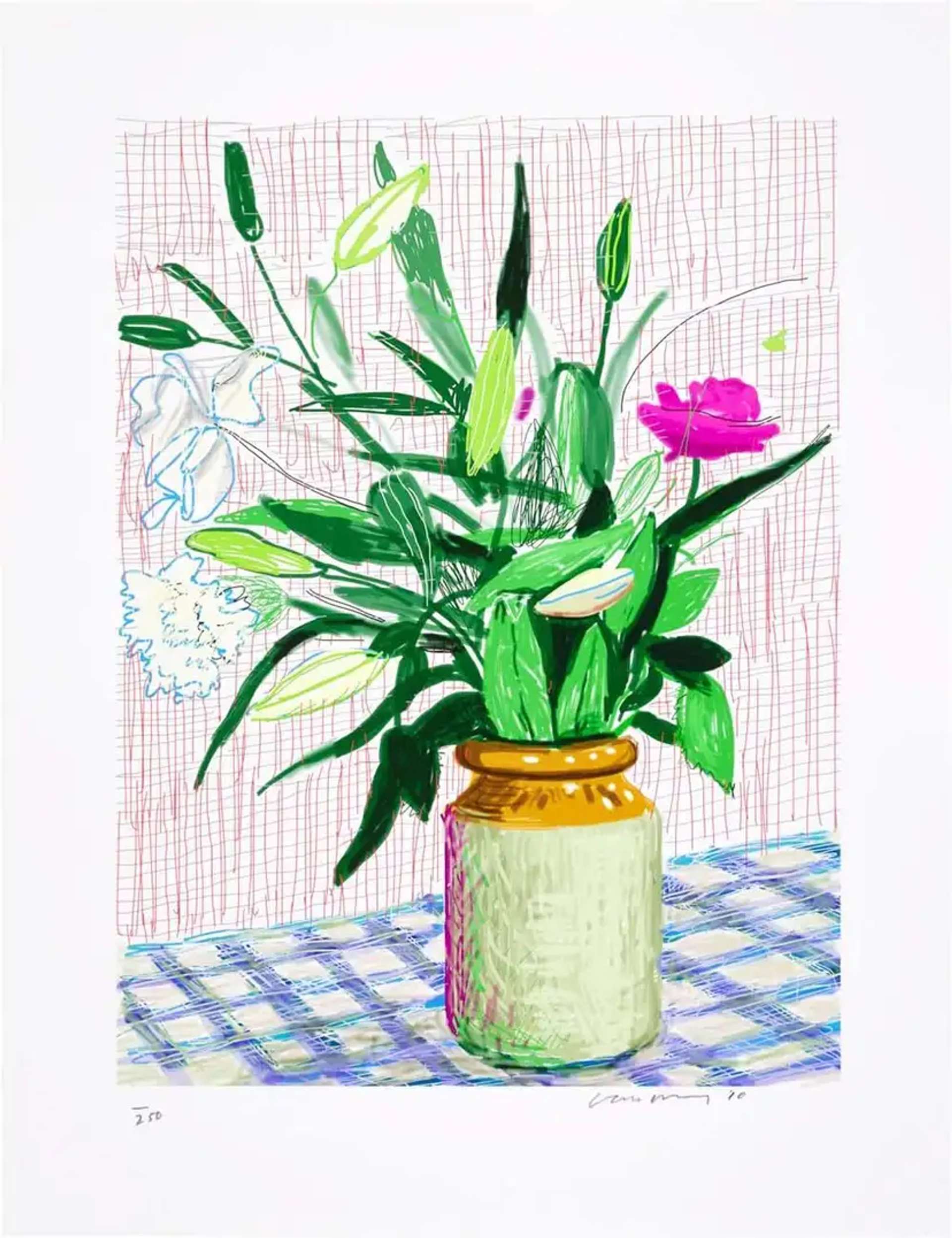David Hockney's Yosemite Suite

 The Yosemite Suite 23 © David Hockney 2010
The Yosemite Suite 23 © David Hockney 2010
David Hockney
651 works
Ever since the 1960s, David Hockney has crafted his art to eloquently master the fusion of technology, nature, and cultural identity. His Yosemite Suite, a vibrant depiction of one of America's most iconic natural landscapes, marks a significant chapter in Hockney's long and illustrious career. This series highlights the breathtaking beauty of Yosemite National Park, a landmark that is defining of his adopted home of California, while also symbolising a deeper connection between the digital revolution in art and the American spirit.
By examining how Hockney's digital canvas redefines our perception of natural landscapes and reflects the quintessential American ethos of accessibility and innovation, it is possible to gain a deeper understanding of his widespread artistic impact. The suite stands as a profound commentary on the intersection of natural beauty, technological advancement, and the democratic ideals embodied in the concept of American national parks.
Hockney’s Journey to California and His Love for Nature
Hockney's artistic trajectory, which saw him traverse continents from the green hills of Yorkshire to the vibrant landscapes of Los Angeles, is as colourful and varied as his artwork. Born in Bradford, West Riding of Yorkshire, Hockney's early life in Northern England laid the foundation for his deep appreciation for nature's beauty. His upbringing in a liberal household fostered a spirit of exploration and self-expression, which became evident in his early works.
His journey began at the Bradford School of Art but it was his time in London, studying at the Royal College of Art (RCA), that catalysed his artistic voice. London's freedom and vibrancy in the 1960s allowed Hockney to explore new facets of art, significantly shaping his approach to capturing landscapes and personal relationships.
In 1964, Hockney embarked on a transformative journey to Los Angeles, drawn by the allure of California's bright sunlight and crisp shadows. The contrast between the grey of post-war Britain and the saturated hues of Hollywood was stark, profoundly influencing Hockney’s style. This new environment was a fertile ground for experimentation, leading to some of his most iconic works. The swimming pools of Los Angeles, in particular, became a recurring theme in his paintings, capturing the essence of Californian luxury and leisure.
Hockney’s fascination with American landscapes extended beyond the urban settings of Los Angeles to the vast terrains of National Parks. His encounters with the grandeur of the Grand Canyon and Yosemite National Park marked a significant shift in his artistic perspective. Places like Pearblossom Highway and the Antelope Valley Poppy Reserve inspired Hockney to challenge traditional visual perspectives.
In many ways, the culmination of this journey was the Yosemite Suite, a vibrant and sun-drenched series that showcases Hockney’s continued fascination with American landscapes. Created during his return to California in 2010-11, this suite reflects the beauty of the Yosemite landscape through Hockney's technologically innovative approach to capturing the essence of nature. His explorations in perspective, light, and colour here are a testament to his enduring love for the natural world and his ability to constantly reinvent his artistic expression in new environments.
National Parks: The Democratisation of the American Landscape
Many nature enthusiasts consider public access to the outdoors a basic human right. The concept of national parks in the United States in particular represents a significant chapter in the history of environmental conservation and democratisation of natural beauty; an initiative that transformed the American landscape into a shared cultural and natural heritage, accessible to all. The establishment of Yellowstone National Park in 1872 marked the world's first instance of wilderness preservation for the public’s benefit, a concept that fundamentally differed from the Old World's perception of parks as manicured gardens or private hunting grounds. This groundbreaking idea reflected a uniquely American experience with wilderness, intertwined with the nation’s democratic ideology and the abundance of undeveloped land at the time. The notion of preserving natural landscapes for public enjoyment and education was revolutionary, challenging the traditional European concept of nature as a resource for the elite. American national parks emerged as symbols of democracy, where wilderness was not only a resource to be utilised but a space for public recreation, reflection, and inspiration.
The democratisation of the American landscape through national parks has had a profound impact on art and cultural perception. Artists, including Hockney, have been drawn to these spaces, captivated by their sublime beauty. These parks have become canvases for artists to explore and depict the United States’ natural splendour, offering diverse perspectives that resonate with a wide audience. They serve not just as sites of natural interest, but as cultural icons that reflect America’s commitment to preserving its magnificent landscapes for everyone.
Hockney: Embracing Accessibility and Digital Art
The advent of digital art has transformed the contemporary artistic landscape, democratising both the creation and consumption of art. Digital platforms have lowered the barriers to artistic exploration, allowing individuals from diverse backgrounds to explore and express their creativity. Digital art is highly accessible, allowing a wider range of individuals to engage in the creative process and. Since digital artworks can be shared globally with ease, they can also reach audiences far beyond traditional gallery spaces. This democratisation breaks down previous barriers present in the art world, allowing more people to participate in and appreciate the artistic dialogue.
Hockney's introduction to digital art began with his exploration of the iPhone, but it was the release of the iPad that marked a significant turn in his artistic practice. Hockney was quick to adopt it, recognising its potential as a powerful tool for artistic creation. The iPad provided a new canvas for Hockney, allowing him to experiment with scale and detail in ways not previously possible with traditional media. In particular, Hockney uses the Brushes app, which allows for intricate layering and a wide range of textures and effects, some of which emulate traditional painting techniques. His digital art is a remarkable example of how these tools can be used to create complex and engaging works, and the app’s ability to record each brushstroke offered Hockney a novel way to revisit and revise his work, further blurring the lines between traditional and digital art forms.
The choice of Yosemite National Park as the subject of this series is in itself a nod to the concept of accessibility. National parks, by their very nature, are spaces of public heritage and shared cultural identity, open and accessible to all. Hockney’s portrayal of this iconic landscape extends this ethos of accessibility into the realm of art, inviting viewers from all walks of life to engage with and appreciate the natural world.
The Yosemite Suite: A Fusion of Technology and Nature
The use of digital media has profound implications for representing natural landscapes in art, a very traditional subject. Hockney’s Yosemite Suite challenges conventional approaches to landscape art. The digital medium allowed Hockney to capture the vibrant colours and grandeur of Yosemite with a new intensity and immediacy. This approach to depicting landscapes presents a more dynamic and fluid perspective, reflective of the ever-changing nature of the natural world. Hockney's digital landscapes open up new possibilities for how we perceive and interact with nature in art, offering a fresh and contemporary perspective that is deeply rooted in traditional artistic values.
In the Yosemite Suite, Hockney's love for nature converges with his innovative spirit. His choice of this medium was not incidental, as the ancient, natural splendour of Yosemite – rendered through Hockney's digital brushstrokes – reflects his unique perspective on the relationship between art, technology and nature. This series is a testament to Hockney's innovative approach to capturing the essence of the natural world, marrying his artistic vision with the technical advancements of his time. As he depicts well-known spots around the park, such as Bridalveil Fall, El Capitan and the Merced River, his mastery of colour and form is on full display – as is his ability to see and depict the traditional subject of nature through a fresh contemporary lens.
Hockney's Impact: Redefining Art in the Digital Age and Bridging Art, Technology, and Nature
Hockney's biggest contribution to the art world is a legacy of innovation and creativity. His work is a celebration of natural beauty and artistic skill, which is fearless in its embrace of the evolving landscape of art in the digital age while remaining true to the artist’s self. In many ways, Hockney's journey challenges our perceptions of art, encouraging a dialogue between the past and the present and bridging the gap between the traditional and the modern. His work in the Yosemite Suite, a harmonious blend of nature and technology, continues to inspire artists and art enthusiasts alike, signalling a future where creativity knows no bounds and is accessible to all. Stylistically, Hockney’s use of bright, bold colours and expansive compositions makes his work instantly engaging and approachable. His style does not seek to intimidate with complexity but welcomes viewers into a world where nature's beauty is simultaneously grand and accessible. This approachability in style aligns seamlessly with Hockney’s broader artistic philosophy, where art is seen as a universal language that transcends traditional barriers.
In examining Yosemite Suite, it becomes evident how it exemplifies Hockney's profound embrace of accessibility in art, which extends to the choice of subject, stylistic execution, and his innovative use of digital mediums. With its vivid depiction of the American wilderness, the series is a celebration of natural beauty, the culmination of Hockney’s journey from Britain to America, and a reflection of Hockney’s democratic approach to art. As we look towards the future of art, Hockney's legacy serves as a powerful reminder of the endless possibilities that arise when we embrace change and innovation. Through his work, he invites us to reconsider our relationship with art, nature, and technology – ultimately encouraging a view of art as an accessible and shared human experience.










